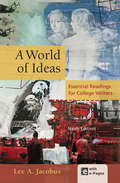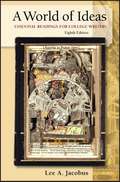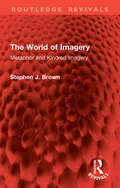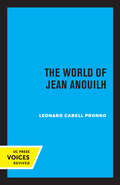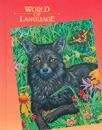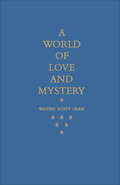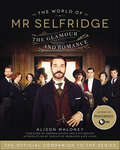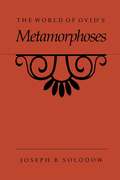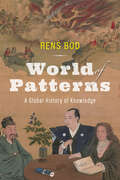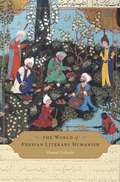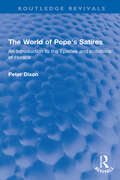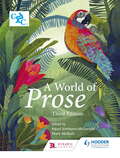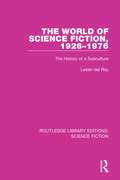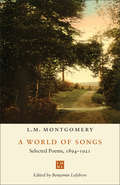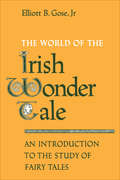- Table View
- List View
A World of Ideas
by Lee A. JacobusThe first and bestselling reader of its kind, A World of Ideas introduces students to great thinkers whose ideas have shaped civilizations throughout history. When students hear names like Aristotle, Martin Luther King, Jr. , Virginia Woolf, or Sigmund Freud, they recognize the author as important -- and they rise to the challenge of engaging with the text and evaluating it critically. No other composition reader offers a comparable collection of essential readings along with the supportive apparatus students need to understand, analyze, and respond to them.
A World of Ideas: Essential Readings for College Writers
by Lee A. JacobusThe most successful reader of its kind,A World of Ideas introduces first-year writing students to the thinkers and writers whose ideas have shaped civilization: for example, Niccolò Machiavelli on government, Elizabeth Cady Stanton on justice, and Sigmund Freud on the mind. Because students perceive these writers as important, they take the writing course seriously: they learn to read more attentively, think more critically, and write more effectively. No other composition reader offers a comparable collection of important readings along with the supportive apparatus students need to understand, analyze, and respond to them.
The World of Imagery: Metaphor and Kindred Imagery (Routledge Revivals)
by Stephen J. BrownOriginally published in 1927, The World of Imagery is a study of the use of metaphor, simile, and other forms of literary imagery from the ancient Hebrew to the early twentieth century. It looks at the theory, including the nature and function of metaphor, followed by the application in various settings and finally showing illustrations and examples in everyday life.
The World of Jean Anouilh
by Leonard C. PronkoThis title is part of UC Press's Voices Revived program, which commemorates University of California Press’s mission to seek out and cultivate the brightest minds and give them voice, reach, and impact. Drawing on a backlist dating to 1893, Voices Revived makes high-quality, peer-reviewed scholarship accessible once again using print-on-demand technology. This title was originally published in 1961.
World Of Language
by Sandra Breuer Judy Brim Wendy DavisThe book that unlocks all imagination opening every mind to new and exciting ideas. World of language is a literature book that indeed enlarges your world to think, read, speak, listen and write.
World of Language
by Burdett Silver Ginn Inc.A resource book for improving writing skills of students.
World of Language
by Marian Davies Toth Nancy Nickell Ragno Betty G. GrayThis text contains unit lessons on Using Language to narrate; to inform; to imagine; to persuade; to describe; to research; to create; and to classify.
A World of Love and Mystery
by Walden Scott CramA World of Love and Mystery is a collection of poetry divided into three parts written by the poet Walden Scott Cram.
The World of Mr. Selfridge: The Glamour and Romance
by Alison MaloneyThe official, full-color, illustrated, behind-the-scenes companion to the lavish hit ITV and PBS television series Mr. Selfridge that vividly brings into focus the remarkable man and his time.Set at the crossroads between the old and the new—when the Victorian and Edwardian eras gave way to the modern age—Mr. Selfridge illuminates the passions, drama, tensions, and promise of the early twentieth century, embodied in one charming, dynamic, self-made man: department store tycoon Harry Gordon Selfridge.Mr. Selfridge follows a colorful cast of characters whose lives and fortunes are entangled with the founder of the magnificent department store that bears his name: Selfridge’s. American retail visionary Harry Selfridge moves to London in 1906 with his family to establish the most ambitious department store the world had ever seen. While his dreams inspire many, they also challenge the staid conventions of British society.A saga bursting with love affairs, class divisions, cultural clashes, ambition, betrayals, and secrets, Mr. Selfridge is set in an era when women reveled in a new sense of freedom and modernity. A charming, dynamic, brilliant, and forceful man who enjoys and respects women, Harry opens the doors of his opulent department story on London's famed Oxford Street to indulge, empower and celebrate them, changing the way the British—and the world—shopped forever.Including a foreword by series producer Andrew Davies, this official illustrated companion to the series—the biggest ITV-produced drama of all time—takes fans on a journey through the world of the series, Selfridge’s, and the larger-than-life entrepreneur, husband, lover, and family man behind it. Rich with historical detail, The World of Mr. Selfridge examines the real man and the fictional character based on him, his relationship with his family, his genius for retail, and his flagship store, including its departments and changing fashions in the early twentieth century.Complete with hundreds of gorgeous photographs, The World of Mr. Selfridge takes a closer look at the cast and their characters over the first two seasons, and looks ahead to series three, which begins in 1919—when Harry’s life really begins to unravel.
The World of Obituaries: Gender across Cultures and over Time
by Mushira EidThe World of Obituaries looks at obituaries as a rich source of information on cultural representations of gender.
The World of Odysseus
by M. I. Finley Bernard KnoxThe World of Odysseus is a concise and penetrating account of the society that gave birth to the Iliad and the Odyssey--a book that provides a vivid picture of the Greek Dark Ages, its men and women, works and days, morals and values. Long celebrated as a pathbreaking achievement in the social history of the ancient world, M. I. Finley's brilliant study remains, as classicist Bernard Knox notes in his introduction to this new edition, "as indispensable to the professional as it is accessible to the general reader"--a fundamental companion for students of Homer and Homeric Greece.
The World of Ovid's Metamorphoses
by Joseph B. SolodowSynthesizing a wealth of detailed observations, Joseph Solodow studies the structure of Ovid's poem Metamorphoses, the role of the narrator, Ovid's treatment of myth, and the relationship between Ovid's and Virgil's presentations of Aeneas. He argues that for Ovid metamorphosis is an act of clarification, a form of artistic creation, and that the metamorphosed creatures in his poem are comparable to works of art. These figures ultimately aid us in perceiving and understanding the world.
World of Patterns: A Global History of Knowledge
by Rens BodA comprehensive account of the methods of knowledge production throughout human history and across the globe.The idea that the world can be understood through patterns and the principles that govern them is one of the most important human insights—it may also be our greatest survival strategy. Our search for patterns and principles began 40,000 years ago, when striped patterns were engraved on mammoths' bones to keep track of the moon's phases. What routes did human knowledge take to grow from these humble beginnings through many detours and dead ends into modern understandings of nature and culture? In this work of unprecedented scope, Rens Bod removes the Western natural sciences from their often-central role to bring us the first global history of human knowledge. Having sketched the history of the humanities in his ground-breaking A New History of the Humanities, Bod now adopts a broader perspective, stepping beyond classical antiquity back to the Stone Age to answer the question: Where did our knowledge of the world today begin and how did it develop? Drawing on developments from all five continents of the inhabited world, World of Patterns offers startling connections. Focusing on a dozen fields—ranging from astronomy, philology, medicine, law, and mathematics to history, botany, and musicology—Bod examines to what degree their progressions can be considered interwoven and to what degree we can speak of global trends.In this pioneering work, Bod aims to fulfill what he sees as the historian's responsibility: to grant access to history's goldmine of ideas. Bod discusses how inoculation was invented in China rather than Europe; how many of the fundamental aspects of modern mathematics and astronomy were first discovered by the Indian Kerala school; and how the study of law provided fundamental models for astronomy and linguistics from Roman to Ottoman times. The book flies across continents and eras. The result is an enlightening symphony, a stirring chorus of human inquisitiveness extending through the ages.
The World of Persian Literary Humanism
by Hamid DabashiWhat does it mean to be human? Humanism has mostly considered this question from a Western perspective. Through a detailed examination of a vast literary tradition, Hamid Dabashi asks that question anew, from a non-European point of view. The answers are fresh, provocative, and deeply transformative. This groundbreaking study of Persian humanism presents the unfolding of a tradition as the creative and subversive subconscious of Islamic civilization. Exploring how 1,400 years of Persian literature has taken up the question of what it means to be human, Dabashi proposes that the literary subconscious of a civilization may also be the undoing of its repressive measures. This could account for the masculinist hostility of the early Arab conquest that accused Persian culture of effeminate delicacy and sexual misconduct, and later of scientific and philosophical inaccuracy. As the designated feminine subconscious of a decidedly masculinist civilization, Persian literary humanism speaks from a hidden and defiant vantage point-and this is what inclines it toward creative subversion. Arising neither despite nor because of Islam, Persian literary humanism was the artistic manifestation of a cosmopolitan urbanism that emerged in the aftermath of the seventh-century Muslim conquest. Removed from the language of scripture and scholasticism, Persian literary humanism occupies a distinct universe of moral obligations in which “a judicious lie,” as the thirteenth-century poet Sheykh Mosleh al-Din Sa’di writes, “is better than a seditious truth. ”
The World of Pope's Satires: An Introduction to the Epistles and Imitations of Horace (Routledge Revivals)
by Peter DixonFirst published in 1968, The World of Pope’s Satires is a stimulating and challenging book showing how the satires written by Pope during the 1730s were not only expressions of his own .poetic personality but were also responsive to the habits and attitudes of the age. The author considers Pope’s uses of some current conversational technique (especially that of ‘raillery’) and of the closely related social ideal of the cultivated gentleman. Pope’s regard for certain personal attributes and moral values – notably hospitality, integrity, friendship, charity and self-knowledge – is examined in two ways; as it expresses itself positively in the satires, and as it is defined negatively by his antipathy towards courtly self-seeking and hypocrisy, contemporary manifestations of acquisitiveness, and the pride associated with neo-stoicism. The final chapter is wide ranging and shows that although Pope is at times representative, and therefore limited, in his response to the pressures and uncertainties of the age, his satires live because of the subtlety of his treatment of such Augustan commonplaces as Order and Balance and the passion and spirit of his writing. This will be an interesting read for students of English literature.
A World of Prose: Third Edition
by Hazel Simmons-McDonald Mark McWattInspire students to enjoy literature while helping them to prepare effectively for the CSEC® examination; ensure coverage of all prescribed poems for the revised CSEC® English A and English B syllabuses with an anthology that has been compiled with the approval of the Caribbean Examinations Council by Editors who have served as CSEC® English panel members.- Stimulate an interest in and enjoyment of literature with a wide range of themes and subjects, a balance of well-known texts from the past and more recent works, as well as stories from the Caribbean and the rest of the world.- Support understanding with notes on each text and questions to provoke discussion, and a useful checklist to help with literary analysis.- Consolidate learning with practical guidance on how to tackle examination questions including examples of model answers for reference.
The World of Raymond Chandler: In His Own Words
by Raymond ChandlerRaymond Chandler never wrote a memoir or autobiography. The closest he came to writing either was in—and around—his novels, shorts stories, and letters. There have been books that describe and evaluate Chandler&’s life, but to find out what he himself felt about his life and work, Barry Day, editor of The Letters of Noël Coward (&“There is much to dazzle here in just the way we expect . . . the book is meticulous, artfully structured—splendid&” —Daniel Mendelsohn; The New York Review of Books), has cannily, deftly chosen from Chandler&’s writing, as well as the many interviews he gave over the years as he achieved cult status, to weave together an illuminating narrative that reveals the man, the work, the worlds he created.Using Chandler&’s own words as well as Day&’s text, here is the life of &“the man with no home,&” a man precariously balanced between his classical English education with its immutable values and that of a fast-evolving America during the years before the Great War, and the changing vernacular of the cultural psyche that resulted. Chandler makes clear what it is to be a writer, and in particular what it is to be a writer of &“hardboiled&” fiction in what was for him &“another language.&” Along the way, he discusses the work of his contemporaries: Dashiell Hammett, James M. Cain, Hemingway, Fitzgerald, Agatha Christie, W. Somerset Maugham, and others (&“I wish,&” said Chandler, &“I had one of those facile plotting brains, like Erle Gardner&”).Here is Chandler&’s Los Angeles (&“There is a touch of the desert about everything in California,&” he said, &“and about the minds of the people who live here&”), a city he adopted and that adopted him in the post-World War I period . . . Here is his Hollywood (&“Anyone who doesn&’t like Hollywood,&” he said, &“is either crazy or sober&”) . . . He recounts his own (rocky) experiences working in the town with Billy Wilder, Howard Hawks, Alfred Hitchcock, and others. . .We see Chandler&’s alter ego, Philip Marlowe, private eye, the incorruptible knight with little armor who walks the &“mean streets&” in a world not made for knights (&“If I had ever an opportunity of selecting the movie actor who would best represent Marlowe to my mind, I think it would have been Cary Grant.&”) . . . Here is Chandler on drinking (his life in the end was in a race with alcohol—and loneliness) . . . and here are Chandler&’s women—the Little Sisters, the &“dames&” in his fiction, and in his life (on writing The Long Goodbye, Chandler said, &“I watched my wife die by half inches and I wrote the best book in my agony of that knowledge . . . I was as hollow as the places between the stars.&” After her death Chandler led what he called a &“posthumous life&” writing fiction, but more often than not, his writing life was made up of letters written to women he barely knew.)Interwoven throughout the text are more than one hundred pictures that reveal the psyche and world of Raymond Chandler. &“I have lived my whole life on the edge of nothing,&” he wrote. In his own words, and with Barry Day&’s commentary, we see the shape this took and the way it informed the man and his extraordinary work.
The World of Science Fiction, 1926-1976: The History of a Subculture (Routledge Library Editions: Science Fiction #3)
by Lester del ReyThis book, first published in 1980, is a guide to the major forces in the subculture of science fiction. It analyses the history of the field and the related developments, for instance the Bomb, that have shaped the literature. It examines the complex of activity and background tradition, the body of accepted beliefs and conventions, and the ethics and values of the world of science fiction.
A World of Songs: Selected Poems, 1894–1921 (The L.M. Montgomery Library)
by L. M. Montgomery Benjamin LefebvreCelebrated as a novelist and made famous by her novel Anne of Green Gables and its sequels, L.M. Montgomery (1874–1942) is far less known for also writing and publishing hundreds of poems over a period of half a century.Although this output included a chapbook and a full-length collection in which she presented herself primarily as a nature poet, most of her poems appeared in periodicals, including women’s magazines, farm papers, faith-based periodicals, daily and weekly newspapers, and magazines for children. As a shrewd businesswoman, she learned to find the balance between literary quality and commercial saleability and continued to publish poetry even though it paid less than short fiction. A World of Songs: Selected Poems, 1894–1921, the second volume in The L.M. Montgomery Library, gathers a selection of fifty poems originally published across a twenty-five-year period. Benjamin Lefebvre organizes this work within the context of Montgomery’s life and career, claiming her not only as a nature poet but also as the author of a wider range of "songs": of place, of memory, of lamentation, of war, of land and sea, of death, and of love. Many of these poems echo motifs that readers of Montgomery’s novels will recognize, and many more explore surprising perspectives through the use of male speakers. These poems offer today’s readers a new facet of the career of Canada’s most enduringly popular author.
The World of Tacitus' Dialogus de Oratoribus
by Christopher S. van den BergComing to terms with the rhetorical arts of antiquity necessarily illuminates our own ideas of public discourse and the habits of speech to which they have led. Tacitus wrote the Dialogus at a time (ca. 100 CE) when intense scrutiny of the history, the definitions, and the immediate relevance of public speech were all being challenged and refashioned by a host of vibrant intellects and ambitious practitioners. This book challenges the notion that Tacitus sought to explain the decline of oratory under the Principate. Rather, from examination of the dynamics of argument in the dialogue and the underlying literary traditions there emerges a sophisticated consideration of eloquentia in the Roman Empire. Tacitus emulates Cicero's legacy and challenges his position at the top of Rome's oratorical canon. He further shows that eloquentia is a means by which to compete with the power of the Principate.
The World of the Irish Wonder Tale: An Introduction to the Study of Fairy Tales
by Elliott B. Gose Jr.Fairy tales are a rich element of childhood in many cultures around the world. But in Ireland, where they are known as wonder tales, these stories of magic and enchantment are not restricted to young audiences; Irish wonder tales are told to adults. So that the modern reader can fully appreciate them, Gose provides an interdisciplinary overview. He identifies a number of approaches – psychological, anthropological, structural, comparative, and typological.
